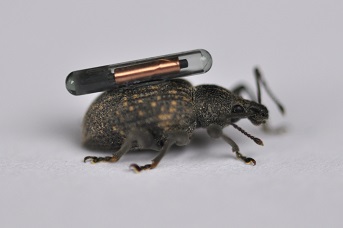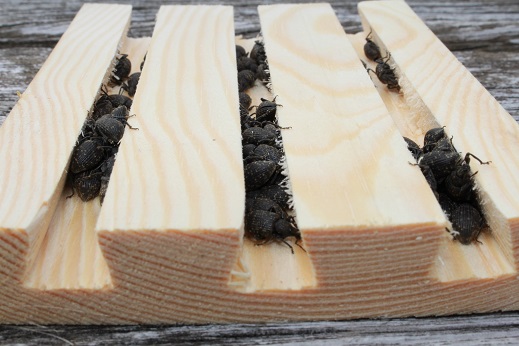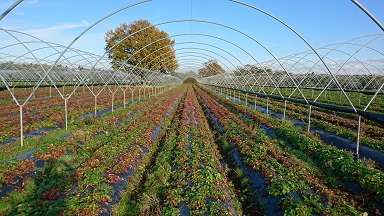Please click here to access the main AHDB website and other sectors.
- Home
- Knowledge library
- Vine weevil in soft fruit: Sources of infestation, behaviour and monitoring
Vine weevil in soft fruit: Sources of infestation, behaviour and monitoring
Discover where the weevil can thrive and how understanding the pest's behaviour can help you keep tabs on its development.
This information was last updated in 2018.
Go back to the main page: Vine weevil control in soft fruit
Sources of infestation
Potential sources of infestation in soft fruit crops include:
- Resident overwintered vine weevil adults or larvae in the previous year’s crop.
- Adults moving into crops from neighbouring infested crops, weeds, surrounding hedges, windbreaks and trees.
- Eggs or larvae in bought-in tray or potted plants.
- Adults moved around on staff clothing and shoes, machinery, punnets, trays, sledges and bins used for transporting propagation material.
Behaviour and monitoring
By understanding their behaviour it is possible to monitor for adult weevil infestations.
Defra-funded studies using tiny electronic tags (see figure 1) have shown that most adult weevils move only short distances (around 40 cm per day) within a favourable strawberry crop.
 RSK ADAS
RSK ADAS
Figure 1. Vine weevil with electronic tag for monitoring movement.
Disturbed
As such, weevils are likely to remain close to the area in which they emerged, unless their habitat is disturbed, or becomes unsuitable for other reasons such as drought, death of host plant or absence of suitable host plants.
Under such conditions, adults are capable of moving over 50m in search of new crops.
Monitoring techniques
Adult weevils tend to become active soon after dusk when they search for suitable host plants to feed on.
A range of differing monitoring techniques can be employed:
- Go out at night with a powerful torch and look for them on the leaves of the crop. As vine weevil adults are very sensitive to movement, but not light, they will rapidly drop off the plant and ‘play dead’ if disturbed, so can be easily missed.
- If plants are gently shaken the adult weevils will fall and can then be easily seen on light coloured surfaces such as white material placed under the plants.
- Also look for vine weevils aggregated together under plastic mulches, ground covers and old leaves and other debris at soil or growing media level as well as in narrow gaps and ridges, such as those found beneath or around the rims of troughs and pots.
Grooved board
Another useful method of monitoring is to place a length of grooved board, piece of corrugated plastic or cardboard under or near to containerised stock.
 T.Pope/Harper Adams University
T.Pope/Harper Adams University
Figure 2. Vine weevil adults congregated under grooved board.
The weevils may congregate under the board and can be found by inspecting it regularly during the daytime.
Use pots
An alternative is to take two plant pots of the same size, fill both with straw and secure the open end of the pots together using some tape.
Place the pots on their side within the crop. The weevils will enter the pots through the drainage holes in the bases of the pots and congregate together in the straw.
Pitfall traps
Create pitfall traps placed close to a suspected infestation. However, bear in mind that such traps will also catch beneficial insects such as ground beetles.
To create a pitfall trap, bury a plastic cup in the ground up to its lip and coat the upper inside edge with grease to stop the weevils crawling out.
To prevent the trap from filling with irrigation water or rain, invert a 3 litre pot (with its drain holes covered with tape) over the pitfall and cut ‘legs’ into the pot’s rim, so the weevils can crawl underneath it into the trap.
Vine weevil traps
Results in AHDB Horticulture-funded project HNS 195 have shown that a commercially-made vine weevil trap is a more effective monitoring tool than grooved boards, corrugated materials or pitfall traps.
This simple trap is made of black plastic and is shaped to allow weevils to enter the trap but not leave.
Although the trap is commercially made overseas, it is not yet available in the UK.
Leaf notching
The most visible sign of infestation throughout much of the year is the feeding by adult weevils that causes notching along leaf margins.
In cane fruit crops, grazing or severing of fruiting laterals may also be observed. It is not always easy to spot this damage however, as it may be hidden or only present on a few leaves or laterals.
In strawberry crops, larvae can often be detected in the autumn months by the appearance of orange/red leaf colours, indicating early symptoms of plant stress.
These symptoms are followed by leaf senescence.
 T.Pope/Harper Adams University
T.Pope/Harper Adams University
Figure 3: Patches of vine weevil-damaged strawberry plants showing orange/red leaf colours and senescence.
Useful links
Vine weevil in soft fruit: Biology and plant damage
Vine weevil in soft fruit: Effects of crop type and production system
Vine weevil in soft fruit: Cultural control
Vine weevil in soft fruit: Biological control – nematodes
Vine weevil in soft fruit: Biological control – nematode application methods
Vine weevil in soft fruit: Biological control – fungi and natural predators
Vine weevil in soft fruit: Chemical control
Biocontrol in Soft Fruit Guide
Download the original vine weevil control in soft fruit factsheet
Original author/s
Jude Bennison, Janet Allen & John Atwood, ADAS
Tom Pope, Harper Adams University
Topics:
Sectors:
Tags:

